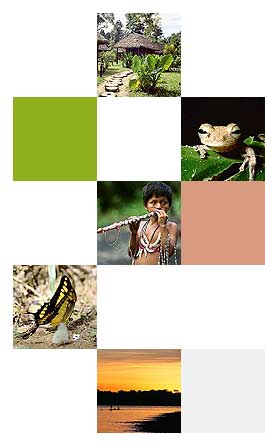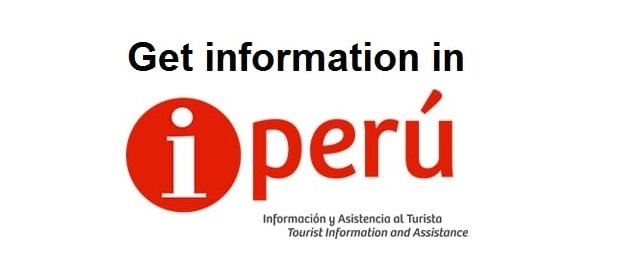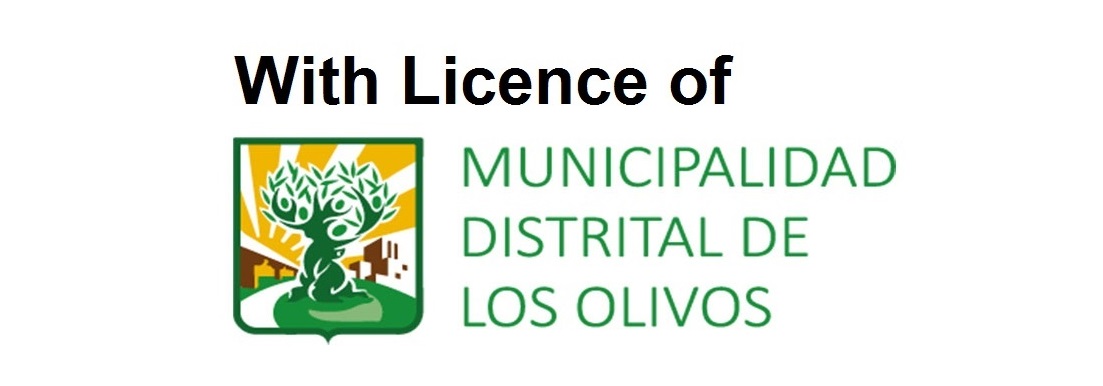

MAIN DESTINIES
RAINFOREST
 The thik jungle of Peru owes its name to a great river generator of life, illusions and legends: the Amazon, discovered in 1541 by Francisco de Orellana, is the longest and mighty river of the world. To sail along its waters is to enter in direct contact with nature and the wisdom of the natives. It is to see the Sun to agonize after the top of the trees and to admire the infinite greenery. The Amazon is an immense river, that flows slowly, that looks like a sea, because in some sectors the width of its current reaches the 4 thousand meters. Its wealth receives the waters of all the rivers that are born in the oriental hillside of the Cordillera de los Andes, which form marshes and labyrinths of channels.
The thik jungle of Peru owes its name to a great river generator of life, illusions and legends: the Amazon, discovered in 1541 by Francisco de Orellana, is the longest and mighty river of the world. To sail along its waters is to enter in direct contact with nature and the wisdom of the natives. It is to see the Sun to agonize after the top of the trees and to admire the infinite greenery. The Amazon is an immense river, that flows slowly, that looks like a sea, because in some sectors the width of its current reaches the 4 thousand meters. Its wealth receives the waters of all the rivers that are born in the oriental hillside of the Cordillera de los Andes, which form marshes and labyrinths of channels.
Rainforest The name of the product of the combination of the two words: ama (break) and zona (boat) that means, Amazonas would mean "breakboats".
MANU
The MANU is located in the south oriental region of Peru. It is one of the biggest parks of South America. The area of the park includes part of the sierra of the department of Cuzco and the jungle of the department of Madre de Dios. The Manu includes two million hectares (4.5 million acres) in a rich territory of species of flora and fauna in a great variety of habitats of Andean height, forest of clouds and tropical jungle. The UNESCO recognizes officially the natural paradise of the Manu as Patrimony of the Humanity, and later in 1997 as World Reserve of the Biosphere, since it shelters the major Biological Diversity in areas protected of rainy forest and from several endemic species of the forest of clouds. The great majority of forests in the world have been impressed by actions of the man; fortunately the Manu is almost intact because it is far away from the civilization.
In addition, we can observe a variety of animals in their different habitats including: Giant Otters (Pteronura brasilensis), the Black Cayman (Melanosuchus Níger), the Majestic Jaguar (Panther Onca), the rare Bear of Spectacles (Tremarctos ornatus), the Tapir (Tapirus terrestris), the Triguillo (Felis pardalis), 13 species of monkeys and approximately one thousand species of birds including seven classes of Macaws.
The Manu also protects the 10 % of the vegetable species in the world, including diverse species of figs and palms, besides the countless species of medicinal plants that nowadays are being classified by scientists. One hectare of the jungle in Manu can shelter more than 220 species of trees, whereas a hectare of forest moderated in Europe and North America might have only 20 species of trees.
Probably the National Park of the Manu is the park protected with major biological diversity in the world.
PUERTO MALDONADO - TAMBOPATA - CANDAMO
In the department of Madre de Dios (its capital is the city of Puerto Maldonado) there are three areas of conservation of great importance:
The Reserve of Biosphere of the Manu (declared by the UNESCO as Natural Patrimony of the Humanity in 1987), the Reserved Zone of Tambopata-Candamo (with intact populations of several species in danger of extinction, as the giant otter and the eagle harpy) and the National Park Bahuaja-Sonene (that shelters 450 species of birds).
A miracle of the nature: that is Madre de Dios, an unknown land of giant trees, powerful rivers and thick hazes, where the man is a stranger, a strange being who shakes on hearing the sighs of the inhabitants of the jungle or on walking along the tortuous rough trails of the mount. Here never reigns the silence. Here everything can happen.
TARAPOTO
The department of San Martin, in the high jungle of the Peruvian nor Orient, is a coloring corner of unusual landscapes and big contrasts, which offers an adventure to the visitor without limits in forests, lagoons, cataracts of dreams and rivers of dizziness.
The history of the department of San Martin demonstrates the fight of the man against a rural geography. Hundreds of years before, the inhabitants of this zone built incomparable citadels, as the Great Pajatén (located in the National Park of the Rio Abiseo), considered the biggest monumental set and of bolder architectural design of Peru.
Created the 14 of September of 1,906, the department of San Martin has in Tarapoto its tourist and commercial axle. The city is in the valleys of the river Cumbaza and Shilcayo and is the center of the terrestrial and air networks among the sierra, the coast and the Peruvian east.
Tarapoto, founded in 1782 by Baltazar Martínez Jiménez of Testicle, is surrounded with impressive tourist attractions. The resort of Cumbaza, the archaeological remains and Polish petroglifos (impressions curved in stone of old civilizations), with motives of plants and animals, the cataracts of Ahuashiyacu and the lagoon Venice, are only some of its magic places.
In the city called "City of the Palms", begins the circuits that allow the discovery of Moyobamba, the capital of the department which is the nailed in the Valley of Alto Mayo or Valley of the Orchids, the province of Lamas, a town that preserves immemorial traditions; the Blue lagoon and the Pretty lake, water mirrors of singular beauty.
For its location, economic and tourist development, Tarapoto is also the door of access to the fort city of Kuelap, in the department of The Amazon.
LORETO
The territory that includes the actual Department of Loreto was part of the Viceroy Ship of Peru and was explored by missionaries who had its see in diverse points of the Peruvian territory. Likewise, the discovery, navigation and exploration of the Amazon were carried out by Gonzalo Pizarro's expedition, which departed from the city of Cuzco. The capital of this vast territory, during the Colonial Epoch, was the old city of Moyobamba, the actual capital of the Department of San Martin.
In the Republican Epoch, its territory was explored along the Amazonian rivers, for distinguished sailors and members of the Peruvian Army like: Carbajal and Portillo. Nowadays, the Army, the Air Force and the Navy of Peru give assistance to the population who live along the rivers and frontier zones, by a civic service established some years ago.
In the last decades of last century, Iquitos, the capital became the most important fluvial port of (shipment) of raw materials of exportation.
Nowadays, the discovery of reserves of oil gives to Loreto new hopes of a better future.
In the banks of the Amazon they have formed towns and cities as Iquitos, the capital of the department of Loreto, which dazzles for its exuberant greenery and the push of the native communities, as the Cocamas, the Witotos, the Boras and the Ticuna, towns which have inherited secrets and thousand-year-old customs.
In 1747 Iquitos was founded by the Jesuit Jose Bahamonde, it is surrounded by the rivers Nanay, Itaya and The Amazon. Warm, exotic and with astonishing greenery, the biggest city of the Peruvian jungle is the door of entrance to sail along the Amazon.

The National Reserve of Pacaya-Samiria
The National Reserve of Pacaya-Samiria is located in the Amazonian region of Peru, to 93 miles from Iquitos. The reserve has triangular and this is among the rivers Marañon and Ucayali. These rivers crossed in the North-East of the reserve, turning into the beginning of what we are called the Amazon.
The basins of the rivers Pacaya and Samiria has been protected by the Peruvian government from 1940. The area was declared National Reserve in 1972 and expanded to its actual limits of 5, 137,000 acres in 1982. The reserve is the biggest of Peru and the second biggest in the Amazonian region, and the fourth biggest of the whole South America. The great size of the reserve assures that this one will be ecological and genetically representative of the whole region, with abundance of areas virtually without changes.
There can be seen red and green Parrots through (Ara chloroptera) through the rainy Amazonian forest.
The aims of the Reserve of Pacaya Samiria are:
- To preserve ecosystems that is representative of the low jungle.
- To foment the studies of flora and fauna in the area.
- To improve and extend the education on the area.
- To interest the local population on the benefits of the conservation and the good-managing of fauna.
- To foment and manage the use of the natural resources according to the appropriate ecological development.
From the aims, the main is the conservation and protection of flora and fauna. Nevertheless an aim is to continue with the use of the natural resources found in the Reserve for the benefit of the people living in the area.
Landscape and Altitude
In the reserve there are two types of landscapes. They are the alluvial plain and some small hills that are in the west part of the Reserve. The altitude of the reserve is among 263 to 675 feet on the level of the sea. The vegetation is very typical of the one that is in a humid tropical forest and is characterized by a great heterogeneity and diversity of species.
Rivers and Lakes
Two principal rivers exist in the Reserve. The Pacaya, a tributary of the Ucayali, flows towards the left bank of the channel Puinahua from Ucayali. Its length is 198 miles approximately. The Samiria, a tributary of the Marañon, flows by the right side of this river. Its length is 214 miles approximately. Both rivers follow a course as they pass for the reserve. Its wide sides are among 164 to 495 feet and its levels of water change according to the station. The condition of the water is low in August and September, and the season of high waters is in February until April.
There are approximately 80 lakes in the Reserve, the most important are the Hatun Cocha, Pastococha, Shinguito, Maldonado, Ungurahui, Yanayacu, Zapote, Yarina.
Animal and vegetal Life
The animal and vegetal life is very abundant and extremely varied. There are more than 132 species of mammals, 13 of which are primates. The spider monkey, the monkey woolly, howling monkey, they are all considered in danger. There exist more than 300 species of birds and 132 species of reptiles.
People
Approximately 47,660 persons who live in the Reserve are located mainly along the edge of the reserve. However, some inhabitants are inside the reserve. The members' average of a family is from six to ten persons and its main food is bananas, yucca and fish. Its main source of food comes from the natural resources found in the reserve. Their houses are done of materials found in the jungle.
















